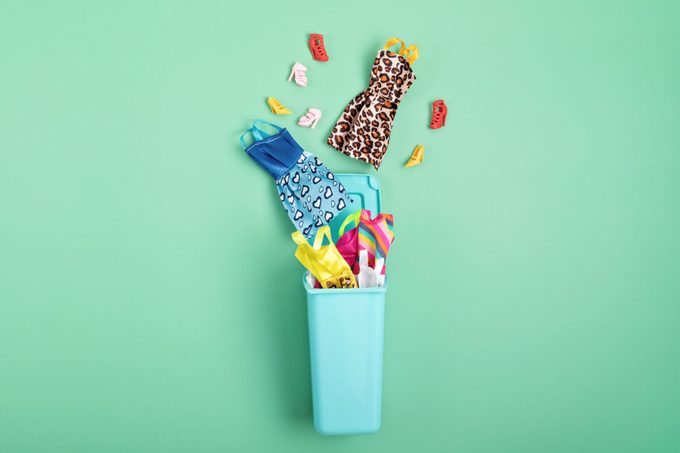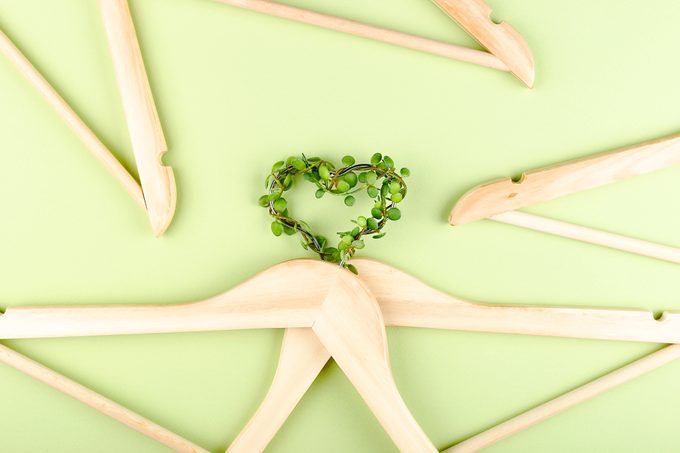If you happen to be seeking to decrease your carbon footprint, undertake a greener way of life, or make a single small adjust that has a optimistic effects, your closet is an uncomplicated location to make eco-pleasant searching selections.

Let us be honest, rapid fashion provides a rapid thrill: inexpensive dresses that allow us to quickly refresh our wardrobes and comply with the latest trends. However, these identical fast-style brands have a whole lot of skeletons in their closets. You know how when a thing appears to be as well great to be real it typically is? In this scenario, these low selling prices are designed doable by shortcuts that damage the environment and the people today who make the apparel.
When a great deal of the duty rests on the shoulders of manufacturers, consumer routines are critical far too, claims Reimer Ivang, founder of Improved Entire world Style, a Danish sustainable trend model. Customers can stand up to the hazards of speedy fashion’s environmental effects by learning to location speedy-manner manufacturers and opting instead to guidance sustainable apparel brand names that use production procedures and components that are a lot more moral and improved for the Earth. And it is not only about what you invest in, it’s also about what you do with the apparel when you are completed with it. You can do great by recycling or upcycling clothing instead of tossing them out.
Before we share ideas on how to store for a lot more sustainable garments, we’re likely to glimpse at just how quickly manner turned so poor in the first place.
Specifically what is quickly fashion?
That $10 dress or $5 T-shirt you see hanging on a retail store rack—chances are, that’s fast trend. The shop that restyles its mannequins in new outfits weekly, or a web-site that updates its offerings each day, which is quick trend too. Basically, low-priced stylish apparel is fast fashion. The phrase refers to a company design where brands established up a procedure to quickly reproduce the most current types noticed on stars and runways to market them to clients for a portion of the charge of designer traces. Collections like these are made on a mass scale that encourage a sample of procuring and discarding things for new outfits at a swift rate.
| The normal runway organization design sees designers building four to six collections in a year. But quick-style retailers can create 12 to 14 collections in that identical time frame! |
How did fast manner materialize?
As not long ago as the transform of the 20th century, the vast majority of clothes was personalized to your body, either in a specialty retail outlet or manufactured at property by hand. Garments could consider months to be manufactured. This all started to change as the assembly traces and factories that had been the hallmark of the Industrial Revolution slowly but surely became a mainstay of garments production—and it has stayed that way at any time given that.
Starting in the 1960s—when the typical American acquired less than 25 goods of outfits per year—fashion started turning around a lot more rapidly, and the producing approach advanced along with it to maintain up with at any time-transforming tastes. Since then, the speed has only quickened: By some estimates, People in america purchased an common of 68 goods of outfits for every yr in 2018. On common, every piece is worn just seven instances in advance of becoming solid apart, in accordance to a person examine. Wherever does all that unused apparel go? To the landfill, to the tune of 10.5 million tons of textiles (the bulk of it outfits) in 2015, in accordance to the Environmental Safety Agency.
Illustrations of quick-manner makes
One of the pioneers of quickly style is the nicely-regarded Spanish brand Zara. Started in 1975, the retailer made its identify making significantly less highly-priced versions of high-conclusion outfits. This design has been copied by many other retailers, which includes H&M, Shein, Boohoo, Uniqlo, Topshop, Primark, Mango, and additional.
How to place speedy-vogue models
Low cost trend is created with low-cost labor and cheap supplies. A few telltale indicators to be on the lookout for include:
- Small cost. A single of the least difficult techniques to location a quick-style brand is to glance at the selling prices. If they’re also superior to be legitimate, they in all probability are.
- Synthetic fabrics. While some top quality products are made with polyester, rayon, and nylon, quick trend usually takes advantage of these additional than normal fabrics these kinds of as cotton and silk.
- Badly accomplished finishing touches. Examine seams and buttons. With speedy manner, seams may well give away conveniently and buttons may possibly be free.
- Rotating stock. Makes that update their inventory weekly or bi-weekly are adhering to the quickly-trend design to preserve customers obtaining, discarding, and purchasing far more.
Difficulties with rapid manner

Getting all those people new items of clothes into the fingers of consumers implies that corners are lower when it arrives to creating, making, and shipping and delivery.
Environmental impact
One particular of the most affordable and most well-liked materials is polyester sad to say, it arrives with a wardrobe-total of troubles. For a person, it will take nearly 432 million barrels of oil yearly to make artificial textiles. This reliance on fossil fuels creates greenhouse gasoline emissions that are linked to climate change. These plastic-based fabrics also pose a threat of shedding microplastics—tiny items of plastic that are 8 mm in length—in the washing device that are then washed into our oceans, the place they pollute the oceans and other waterways.
Even organic materials are problematic when utilised by rapid-style vendors. In 2019 alone, conventional cotton crops grown in the U.S. expected 68 million lbs . of pesticides. These chemical substances do not just sit on cotton crops, they contaminate soil from runoff water and pose a possibility of drinking water and soil contamination for community communities.
Rapidly trend does not get much much better when it comes to the subsequent phase in the design and style process—achieving all those stunning shades. It usually takes up to 200 tons of drinking water to create a ton of dyed clothing. Worse nevertheless, the common dyes utilized are a mixture of chemical substances that really do not crack down correctly as they enter rivers and oceans. Over the yrs, these substances accumulate in the surroundings, and in some circumstances, waterways near to factories where runoff h2o from the dyeing process enters have grow to be also dangerous to use. A person instance: In China, a global capital of the apparel producing marketplace, extra than 70 percent of the rivers are contaminated and deemed unsafe for human use. You can do your element to preserve drinking water at residence.
The human price
Inexpensive outfits is made by low-priced labor: 30-5 cents for each hour—that’s the wage for manufacturing unit workers who deliver clothes for some preferred stores.
Sometimes doing the job circumstances are unsafe as well. The 2013 incident at the Rana Plaza setting up in Bangladesh highlighted the price of quick fashion when the making that housed 5 garment factories collapsed, killing far more than 1,000 garment personnel. The tragic incident shone a highlight on the inhumane circumstances at the manufacturing facility, such as slave wages, labor rights violations that involved 14-hour workdays, physical and verbal abuse, and exposure to toxic chemicals.
Unfortunately, these concerns are still mainly unaddressed throughout the manner field, and human legal rights teams are continuing to fight for workers’ rights. A single way you can enable is to store for manufacturers that are Fair Trade Accredited.
Affect on animals
Animals are harmed by quick-fashion creation in a quantity of strategies. The microplastics mentioned earlier mentioned really do not just pollute oceans, they are also dangerous to marine daily life. Sea creatures, from small lugworms and shrimp to huge whales, ingest microplastics. When the effects of microplastics on sea life are still currently being examined, investigate has proven that in smaller sea animals they can block their digestive tracks and lead to starvation.
Then there are the threats to their habitats. Rayon and viscose are created of wood pulp. Total forests in Indonesia, Canada, and the Amazon have been logged to make garments, destroying animal habitats in the method.
And finally, the most immediate impression is to the animals elevated and frequently slaughtered for the supplies they generate, this sort of as silk and leather-based. Even though there are arguments for keeping away from all elements that appear from animals, the kinds made use of by rapidly-vogue brands are especially egregious. For instance, some silkworms are boiled alive so that the silk from their cocoons can be harvested. (Wild silk or peace silk, wherever the moth leaves its cocoon guiding, are thought of additional humane alternatives.)
Disposable garments
Most of the clothing designed by quickly-style merchants finally finishes up in landfills some estimates propose that the regular American throws absent 82 kilos of outfits just about every calendar year. “Because clothing is inexpensive and plentiful, we put on every piece significantly less and throw it out at higher charges than in the past,” says Karla Magruder, founder of Accelerating Circularity, a group that encourages recyclable fashion. “People in the U.S. throw absent around 11 to 12 million tons of textiles for every calendar year,” she states.
So, what can we do now?

Now that you know what quickly manner is and have a greater strategy how to place these brands, you can start out to look for out much more sustainable style decisions. At initial, you may possibly be tempted to embrace H&M’s “conscious” line or Boohoo’s newest “sustainable” assortment. But, be mindful that these typically sum to almost nothing greater than greenwashing. “Many companies use the term [“sustainable”] to display that they’ve changed a little proportion of faulty business enterprise types, but they’re considerably from currently being a aspect of the resolution,” Ivang suggests.
Alternatively, a smarter thought is to search for sustainable makes that have designed sustainable manufacturing tactics into their company design from the begin. That can incorporate sourcing normal or organic and natural fabrics (GOTS-accredited is the gold conventional) and ensuring that their garment workers are paid out a livable wage and have honest doing the job circumstances.
Another way to embrace sustainability is to shop fewer, purchase vintage or secondhand, dress in things extended, and recycle or upcycle your clothing as an alternative of throwing out aged merchandise. Recycling your clothing can have the included profit of creating resources for makes that repurpose present materials as an alternative of relying on new resources, clarifies Magruder.
What’s future for style?
There are a good deal of modifications that want to occur to make the marketplace superior for both the ecosystem and the people today who make these clothes.
A garment’s lifecycle—from the raw components made use of to the duration of time a garment is worn and how its discarded—is important to building a superior vogue product. “The fashion market desires to understand how to make fewer, additional tough clothes that are built in a way that permits them to be readily recycled,” Magruder states.
As shoppers, we really do not have to hold out for fast-vogue brands to recycle and develop better outfits. We can start supporting sustainable style makes, purchasing fewer in general, and upcycling and recycling our outfits. If you’d like to master extra about imaginative suggestions on how to upcycle apparel, go through about Ocean Sole, the Kenyan-dependent team turning discarded flip-flops into beautiful artwork.
Resources:
